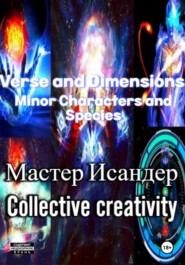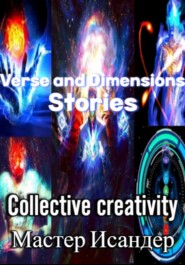По всем вопросам обращайтесь на: info@litportal.ru
(©) 2003-2025.
✖
Verse and Dimensions: Structures
Настройки чтения
Размер шрифта
Высота строк
Поля
Types of Universes
Due to special properties a universe can have, it may be categorized differently from most since it's not just the laws of physics and possibilities that are different.
Multiversally bounded
These are universes that are born in multiverses, born from big bangs. These are the most likely to give birth to powerful civilizations since they are more safe and less bounded than other types of universes.
Soverses
If a universe is kicked out of a multiverse or is created outside of a multiverse, then it is categorized as a soverse, which is short for solo universe. These universes are usually more static than most since it is dangerous for an object with the dimensionality level as much as a universe to enter intermultiversal space. Even if a life where to from on a soverse, it is very unlikely for it thrive let alone survive long periods of time, even if they a civilization emerges, it is unlikely for it to reach Type ? because of the huge distances between it and a multiverse.
Innaturalis
Latin for "unatural" any universe falling into this category is created by an advanced civilization or cosmic entity. They are not born from big bangs and are usually unnaturally organized and/or have properties meant to create and/or keep certain things. If a universe falls into this category, it could still be categorized as Multiversally bounded or Soverse.
Pocket Universe
These are universes in which they come from a host universe; they are pockets of physics and possibilities different from the original universe but is not different enough to break free from it whether in space or time. They often confused with parallel universes because they are slight changes in possibility and laws of physics, but if they still exist in the same timeline or the smaller universe is still inside of the larger, than it is a pocket universe.
Multiverse
A multiverse is a set of a finite or possible infinite number of universes, frequently interpreted as a space containing distinct, typically non-interacting universal "bubbles". Occasionally, the term is used to define the hypothetical set of every single possible universe, including the universe in which we live.
A number of distinct multiverse hypotheses exist that can describe multiverses in various ways, but in essence the feature in common is that they involve multiple universes or realities distinct from each other and from the one that we, or at minimum a single observer, experiences.
The various universes within a multiverse are called "parallel universes,” "other universes,” or "alternate universes.” It is possible to classify a multiverse based on what types of universes it contains and how they relate to each other (see Altverse).
Dimensionality
The dimensionality of a multiverse depends on the specific interpretation of the multiverse taken.
A simple conception of a multiverse is 5-Dimensional space, with several four dimensional universe-"lines" arranged in a stack in a 5 dimensional space.
One can also construct a multiverse with the same dimensionality as the universes it contains; if the universes are finitely large, they can simply sit inside a larger space like bubbles in a volume of water. Provided that the multiverse is negatively curved, one can even fit infinitely many infinitely large universes of the same dimensionality inside. In this model, each infinite universe is a horohyperball bounded by a horohypersphere. Using a Poincarе hyperball model to model the geometry of such a multiverse, every representation of an infinite universe would be a hyperball tangent to the outer boundary of the unit hyperball.
The most extreme conception of the multiverse has them be infinite dimensional, with the coordinates of a point in the multiverse representing the complete state of the universe located at that position (such a multiverse can also be called a phaseverse).
Multiverses as Generalization
A feature common among many cosmologies is to take a multiverse as a generalization or abstraction of the universes it contains: for example, whereas a single universe might have a single mathematical basis for its laws of physics, a fixed number of dimensions, a single set of fundamental constants, and an initial condition, a multiverse can be constructed in which every universe has three of these four held constant but the other is free to vary between universes. One operation by which this may be done is the power-set, which has the useful property in that the "size", in one sense, of a multiverse containing infinitely large universes is one beth number larger than that of those universes.
In this model, it then becomes feasible to introduce a megaverse as a structure that behaves like a "multiverse of multiverses", perhaps losing another feature in common among the universes it contains, and to continue ad infinitum in what is called an archverse chain.
Tegmark Multiverses
While his writing is inconsistent with the description given above, it is nonetheless common for discussions of the multiverse to bring up the work of physicist Max Tegmark, who proposes that cosmology may be layered up to four levels deep, each one requiring fewer assumptions about physics than before. As such, these levels are outlined below for whatever reference purposes they may be needed for.
Type I
A Type I multiverse, the least like a multiverse as written above, is a natural consequence of an infinite, isotropic, homogenous universe: if the probability of a cosmological region – be it a cubic centimeter or a Hubble volume – having certain contents in a certain arrangement after the Big Bang is nonzero, then an infinite universe would contain infinitely many such regions. Popularly, this argument is taken to mean that an exact copy of our own observable universe exists somewhere else in the universe. It can be crudely estimated that identical regions the size of our Hubble volume are spaced apart by approximately 10^10^115 meters, identical regions 100 light-years in radius are spaced apart by approximately 10^10^91 meters, and identical copies of a person are spaced apart by approximately 10^10^29 meters.
Type II
A Type II multiverse would instead be a consequence of the chaotic inflationary theory of cosmology, which purports that quantum fluctuations shortly after the Big Bang created mutually inaccessible pockets of space that, having evolved differently from the unified high-energy physics before them, may have ended up with different physical constants or even geometries. In the nested interpretation, each pocket could itself be a Type I multiverse. Such an argument is sometimes invoked to explain apparent cosmological fine-tuning, in which an infinite number of different, perhaps inhospitable, universes exist alongside our own so that our physical constants thus come across as less extraordinary.
Type III
A Type III multiverse would be a consequence of the many-worlds interpretation of quantum mechanics, in which quantum events with probabilistic outcomes resolve in all ways at once, passing into a vast number of Everett branches each considered to be its own universe. Such a multiverse would function identically to a Type I, only in alternate quantum branches rather than alternate locations in 3-space; one could model a divergence as either a single branch that splits into two, or as a pair of Hubble volumes in the Type I multiverse which begin to differ only upon the resolution of one particular quantum function, If a Type III multiverse is working with infinite Higher Dimensions, where each Higher Dimensions Transcend infinitely uncountable one another, one should not compare any Higher Dimensions, as each of them is infinitely countless above one another, so it will never end, as it will infinitely countlessly piling upwards for all eternity, forming the infinite Higher Dimensions that exist in the Type III multiverse.
Type IV
A Type IV multiverse abstracts even further from the above, positing that alternate spaces with different general principles of physics and mathematics exist independently of ours. Tegmark asks "why these equations and not others?" and resolves the question with the assumption that any other set of equations also exists as a distinct mathematical – and thus physical – structure. This may be analogous to a megaverse or gigaverse, in which one needs even fewer starting assumptions than a set of laws of physics. It contains all mathematics.
Multiverse and Omniverse
It is common, especially in fiction, to see the terms "multiverse" and "omniverse" used interchangably to describe a set of universes, often specifically written as the set of all possible universes or all fictional universes. On this wiki, the omniverse is taken to be some number of levels above the multiverse, perhaps infinitely many, but neither one is seen as an insurpassable boundary. Because fiction can be written involving structures beyond a multiverse or omniverse, interpreting either as a container of all fiction, human thought, or otherwise is incorrect by this view.
Interdimensional Void
An Interdimensional Void is the area in between every single verse, dimension, realm, etc. in a multiverse.
Extra universal space is the term for the empty void of pure vacuum (or, in some interpretations, nothing at all) filling multiverses in between the universes inside. It is essentially a smaller-scale version of The Outside or perhaps even the "place" known as Beyond. Some methods of travelling between universes involve going through this space. It has an arbitrary number of dimensions in both space and time.
This "space" does not always have to exist. Multiverses can be constructed so that all of their universes are in the same spatial location but overlapped on top of each other, and there are undoubtedly many other ways to arrange a huge or infinite number of universes without needing a space beyond it.
Megaverse
A Megaverse is a collection of multiple different Multiverses, either a finite or infinite amount of them, usually each having different properties and interuniversal laws, such as different cosmic events being possible, such as Big Booms, etc.
A megaverse can be contained by a Gigaverse or a Teraverse, or other -verses in the metric hierarchy, but this eventually leads back up to the Archverse chain.
To inhabitants of a multiverse, other multiverses in the same megaverse can be referred to as parallel multiverses, alternate multiverses, or simply other multiverses, depending on the degree of similarity between multiverses in the megaverse. The former two are multiversal analogues of altverses. Some civilisations call the Megaverse an Omniverse, since they haven't discovered the Gigaverse yet.
The most common form of Megaverses (which are beyond the concept dimensionality and beyond mathematics) are stacked on top of each other in a metaphysical space, with multiple being stacked on top of each other in one Gigaverse.
Gigaverse
The Gigaverse is the fourth nested level of the metric -verse series and the lowest-level archverse. This archverse contains infinite amount of megaverses, which are the third nested level. The higher megaverse in the hierarchy surpasses the lower one just as the lower one surpasses the Nullverse. Gigaverse is unattainable by any extension of megaverse hierarchies.
Teraverse
The Teraverse is the fifth nested level of the metric -verse series and the second lowest-level archverse. This -verse contains infinite amount of gigaverses, which are the fourth nested level. The higher gigaverse in the hierarchy surpasses the lower one just as the lower one surpasses the Nullverse. Teraverse is unattainable by any extension of gigaverse hierarchies.
Petaverse
The Petaverse is the sixth nested level of the metric -verse series and the third lowest-level archverse. This -verse contains infinite amount of teraverses, which are the fifth nested level. The higher teraverse in the hierarchy surpasses the lower one just as the lower one surpasses the Nullverse. Petaverse is unattainable by any extension of Teraverse hierarchies.
The Petavere density depends on the region. The center of the Petaverse is the densest, which is noticeable by its bright blue color. The outer regions are the least dense. The beyond dimensional outer gaps are incalculable here.







